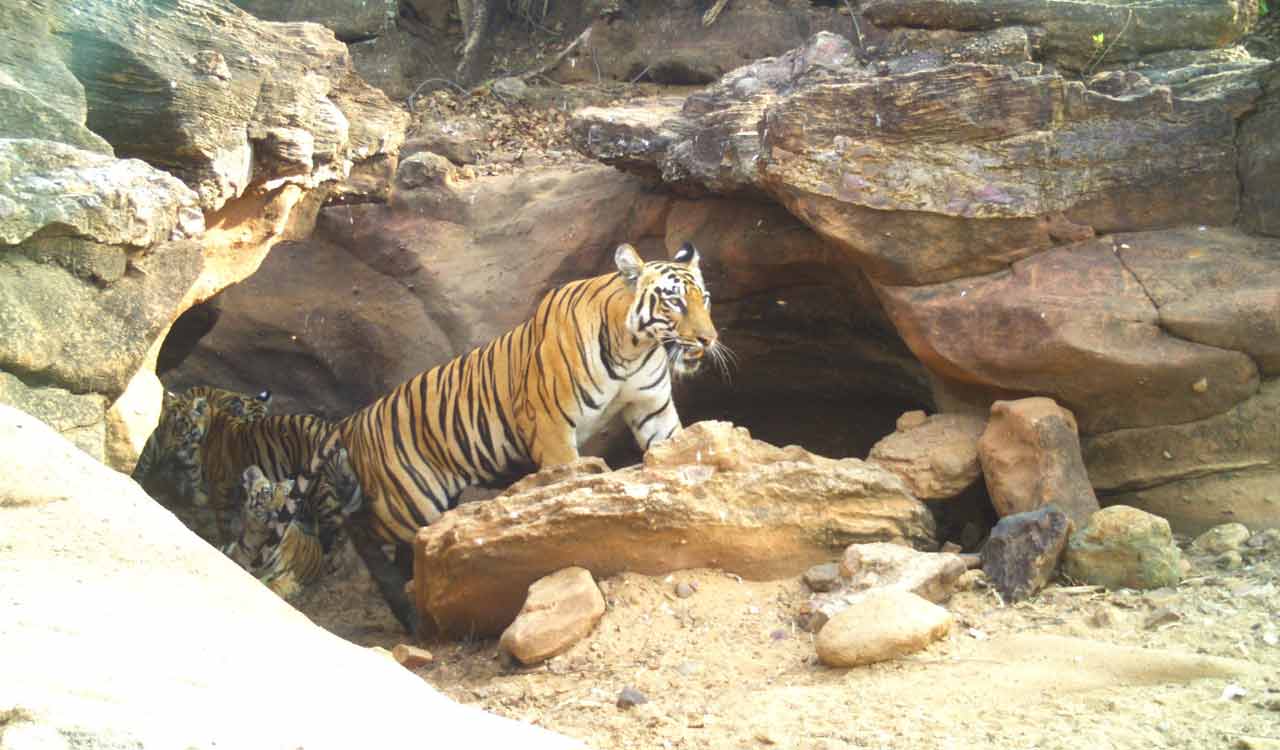Of late, the tigers, drifting in from Tadoba-Andhari, Navegaon Nagzira, Bore and Indravati Tiger Reserves of Maharashtra into the forests of Kawal Tiger Reserve and its corridors often attack humans when confronted.
Published Date – 05:52 PM, Thu – 14 December 23

Tigress Phalguna and its two cubs in a den in Asifabad in 2016.
Kumram Bheem Asifabad: The Kawal Tiger Reserve (KTR), which did not have the presence of tigers as per the status report of the National Tiger Conservation of India in 2022, however holds the potential to accommodate tigers from Maharashtra if protective measures are ensured, according to the report.
The report assumes significance now with the district seeing a significant rise in not only migration from the neighboring State, becoming a breeding zone for tigers over a period of time, but also in man-animal conflict in recent times. Of late, the tigers, drifting in from Tadoba-Andhari, Navegaon Nagzira, Bore and Indravati Tiger Reserves of Maharashtra into the forests of Kawal Tiger Reserve and its corridors often attack humans when confronted.
These migrant tigers are said to have killed three humans and attacked at least two persons in the forests of the district from 2020 to 2023. A tiger named A2, after reaching here from Maharashtra, allegedly killed two tribal youngsters in a span of 20 days triggering panic among locals and dwellers of forest fringe villages in Kagaznagar division in 2020 alone.
Notwithstanding the disturbing man-animal conflict, the forests of KTR, Asifabad, Adilabad and Chennur have attracted around 10 tigers from Tadoba-Andhari, Navegaon Nagzira, Bor and Indravati reserves from 2016 to 2023. The migrant tigers have made the forests of Asifabad, Kagaznagar and Chennur their homes. Some of them have given birth to cubs, resulting in a substantial rise of tiger population in this landscape.
For instance, Phalguna, a tigress from Tadoba Andari migrated into the forests of Kagaznagar in 2015 and gave birth to nine cubs in two litters in 2016. Its offspring delivered four cubs in two litters subsequently. According to Forest officials, about 10 adults and five cubs were residing in the forests of the district and Chennur division.
“Tiger population in Kawal tiger reserve has vanished locally and currently no tiger presence was reported. However, four adults and three cubs were photo-captured in the Kawal corridor (in Kagaznagar) within the greater Kawal landscape can act as a source for recovery,” the report pointed out, cheering forest officials and environmentalists.
The 42nd reserve of the country, the KTR encompasses an area of 1,015.35 square kilometers in Mancherial, Asifabad, Nirmal and Kumram Bheem Asifabad districts. The reserve plays a crucial role in facilitating the movement of tigers between Tadoba-Indravati-Tipeshwar, provided that the intervening habitats remain connected, the report observed. The distance between Kawal and Tadoba Andhari is barely 100 kilometres.
The report cautioned that the corridor connecting Kawal and tiger reserves of Maharashtra faces threats from anthropogenic pressures such as mining activities and the expansion of road and rail networks. “To address these challenges, it is necessary to implement wildlife-friendly and permeable infrastructure to facilitate safe wildlife movement. It is crucial to adopt environmental protection measures, establish wildlife passageways, and promote environmentally friendly mining methods,” it underlined.


